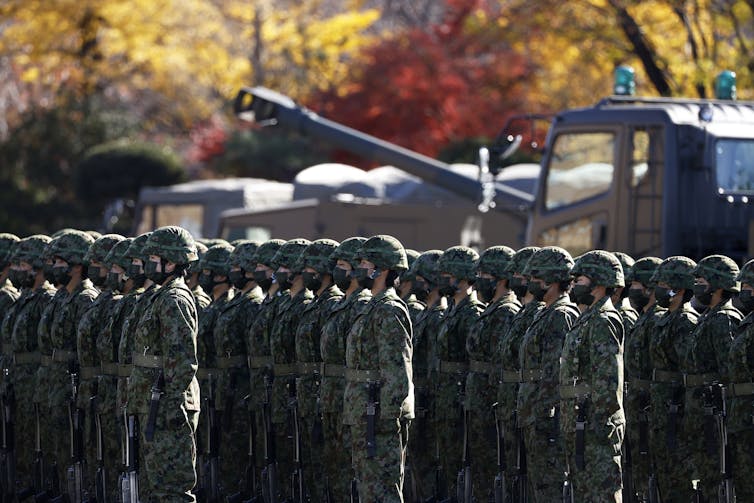[ad_1]
Japan is proposing to double its defence funds to round £86 billion, or 2% of its GDP. This transfer – like current pledges by Germany to massively enhance its navy spending within the wake of Russia’s invasion of Ukraine – brings the nation full circle because it was militarily neutered following defeat within the second world conflict.
Japan’s Liberal Democrat authorities mentioned the choice, which it introduced on the finish of April, had been prompted by the battle in Ukraine, but additionally mirrored rising regional stress from China, North Korea and Russia. Defence minister Nobuo Kishi mentioned the rise in spending was designed to present Japan “counterstrike capabilities” to defend towards aggression within the area.
The US has been pressuring Japan for a while to extend its defence spending to share the safety invoice within the Asia-Pacific area. Doubling its defence funds brings Japan consistent with the benchmark for Nato nations’ navy spending and positions Japan more and more extra as a real ally, relatively than dependent, of the US within the area – a place it has held since American occupation forces drafted a “pacifist” structure to forestall any recurrence of Japanese imperial ambitions.
The structure prohibited using drive and the upkeep of armed forces, regardless of the later creation of Japan’s Self-Protection Forces (JSDF). This was thereafter mixed with a notional 1% of GDP cap on defence spending, in addition to three non-nuclear ideas banning nuclear weapons being “produced, possessed or permitted entry”.
To today, the structure and its anti-militarist Article 9 stay unchanged. However Japan is pacifist in title solely. The method of Japan’s remilitarisation has been occurring because the quick postwar interval. However the timing and rationale behind this newest transfer are important.
Since its rise to worldwide prominence after the Meiji Restoration and victory within the first Sino-Japanese conflict (1895), Japan has gone via a sequence of international coverage shifts. These have fluctuated dramatically, from imperial aggressor (Thirties) to pacifist (Nineteen Fifties) and center energy (2000s).
Within the present period, relations with Washington have been paramount. However with America seemingly overstretched and in decline, Tokyo’s transfer to strengthen its navy and deepen the alliance poses questions on Japan’s safety identification. It additionally raises issues of entrapment into American proxy wars and growing financial involvement within the US “military-industrial complicated”, the system by which the defence sector encourages arms spending and conflict.
Doubtful motives
The newest rise in defence spending is mixed with deepening interoperability between US navy items and the JSDF. It additionally paves the way in which for Japan to contribute billions of {dollars} to an arms and safety infrastructure business that’s booming within the wake of Russia’s invasion into Ukraine.
All this whereas Article 9 of the structure stays unaltered in Japanese regulation. On paper this supposedly maintains a so-called “cap within the bottle” of militarisation. However since modifications to the structure’s interpretation ratified in 2015, Japan’s international coverage has more and more resembled that of a fantastic energy.

EPA-EFE/Kiyoshi Ota/pool
Right this moment, Japan is fervently supporting the Biden administration’s bundle of punitive sanctions towards Russia and elevated help to Ukraine. This contains additional makes an attempt to justify what already seemingly quantity to violations of Article 9.
Japan’s navy spending (already the ninth highest on the planet) itself evidently contradicts the clause. Remarkably, the JSDF additionally now has everlasting operations bases as distant because the Horn of Africa. And the Japanese defence ministry is successfully supplying logistical supplies to Ukrainian forces in a fight zone.
Regional relations and US alliance
The important thing level of concern right here is that Article 9, the 1% GDP defence funds cap and non-nuclear ideas mixed to allay the fears of regional powers that Japan would possibly try and return to its colonial previous. Home debate over whether or not the clause must be reformed or scrapped has intensified, however Japan’s former Asian conquests, together with China, resolutely oppose constitutional reform.
Article 9’s malleable reinterpretation subsequently displays Japan’s tough place between Asia and the US. That is compounded by the political capriciousness of prime minister, Fumio Kishida. Touted as a liberal, his international coverage has grow to be nearly as hawkish as his conservative predecessors. And he now leans in the direction of a relationship so near the US that it dangers entanglement in abroad conflicts.
Tokyo’s more and more well-funded navy, backed by a coastguard that rivals many nationwide navies, leaves little question as to the sturdy transformation of Japanese forces in materials phrases. However the query stays as as to if China’s rise and North Korea’s sabre rattling actually quantity to the “harmful” and “dynamic” safety atmosphere getting used to justify these modifications.
Nationwide identification
This can be a query of identification in addition to practicality. Japan must be clear about its regional and international roles. It has the third largest economic system, the ninth costliest navy and important affect throughout many main worldwide establishments, such because the UN and IMF. But nearly half the Japanese public are towards revising Article 9. They’re pleased with Japan’s peaceable society and positively don’t search growth or entanglement in American wars.
That was, a minimum of, till now. By invoking struggling in Ukraine, Japan’s authorities and mainstream media seem to have stumble on a method by which to rework sympathy into motion backed by well-liked assist. Tokyo has ramped up refugee intakes to unprecedented numbers, donations to Ukraine have dramatically elevated and navy spending has reached a stage akin to western allies.
Intuitively, this may increasingly appear to be a optimistic indicator for the way Japan would reply to a contingency nearer to dwelling, akin to Chinese language aggression directed in the direction of Taiwan. In actuality, nevertheless, this shift in Japan’s international coverage must be trigger for concern, for it dangers stoking future conflicts. As Beijing stalks Taipei within the wake of Moscow invading Ukraine, Japan must be considering earnestly about restoring its pacifist identification earlier than the light pages of its ageing structure are torn up altogether.
[ad_2]
Source link















